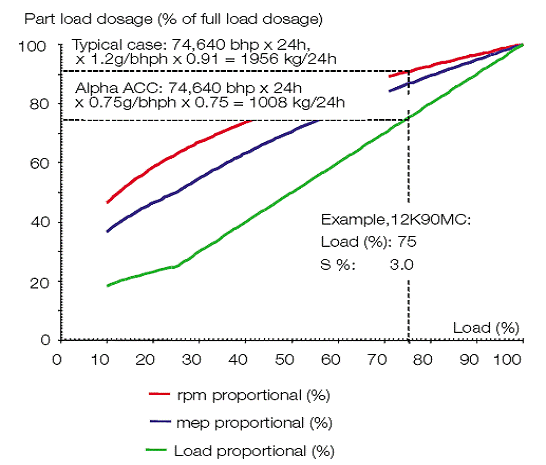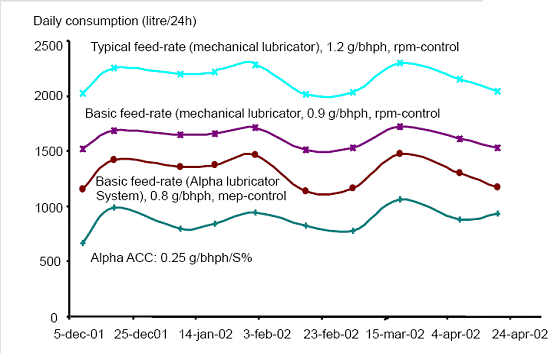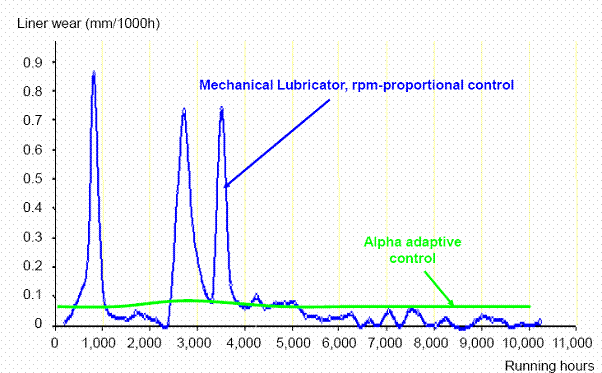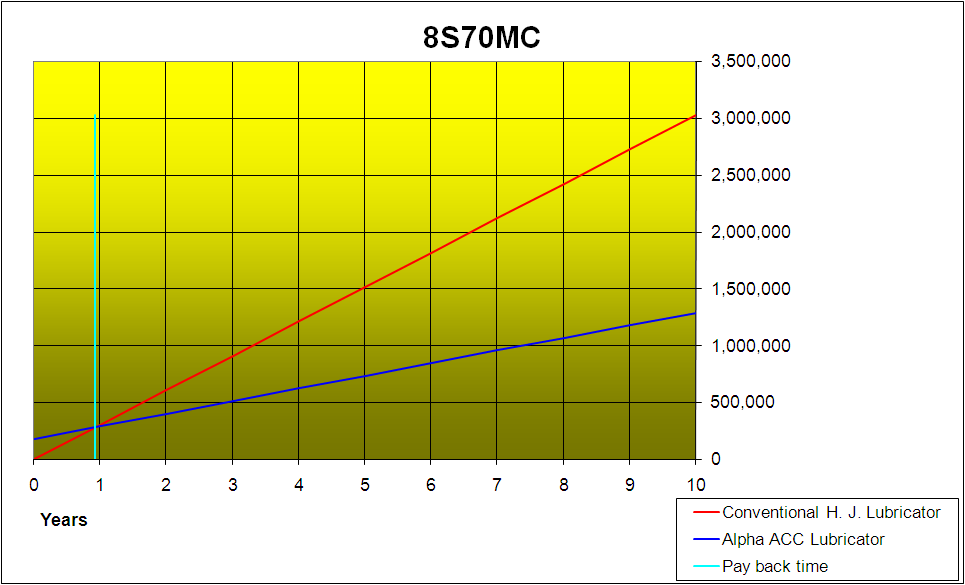| INTRODUCTION | ACTUAL SET UP | COMPARISON | PROJECT SET UP |
| INSTRUCTION | CIRCUIT DETAILS | HARDWARE | CONCLUSION |
|
ASSESSMENT OF ALPHA ACC |
3.1 LOAD DEPENDENCY OF CYLINDER OIL DOSAGE
The following figure illustrates the control of the cylinder oil dosage, proportional to,
1. 1. The engine load
2. 2. Engine RPM
3. Mean Effective Pressure in the cylinder
At part load, load-proportional cylinder oil dosage will provide large cost savings and also reduce the environmental impact from excessive lubrication. Below 25% load, the load-proportional lubrication is stopped and rpm-proportional lubrication takes over as seen in the figure.
Referring a point on the graph at 75% loading
a. a. Lubrication based on Load percentage shows a daily cylinder lubricant consumption of 1956 kg.
b. b. Alpha ACC system graph shows a daily consumption of 1008 kg.
That gives a saving of nearly 100kgs of costly lubricant.

Figure 3.1: Comparison between Load Dependencies different lube oil controls.
3.2 DAILY LUBE OIL CONSUMPTIONS
This is very clear from the figure that by adopting Alpha Adaptive cylinder oil control, daily consumptions of cylinder lube oil will be reduced to minimum when compared with other mechanical lubricator based on rpm proportional control.

Figure 3.2: Daily consumption, Comparison between different lube oil controls
3.3 CYLINDER LINER WEAR COMPARISON
The results which were revealed through very frequent cylinder liner wear measurements and even more frequent drain oil sample analyses shows that the wear- peaks can be avoided by increasing the cylinder oil dosage. However, such a simple increase will increase the expenses on cylinder oil dramatically and, furthermore, it will increase the risk of scuffing during periods of operating at part load and/or with low-sulphur fuel (’bore polish’).
With Alpha ACC, such risks are eliminated, and it is expected that cylinder liner wear will become stable and predictable over time and low on average.
The first cylinder wear measurements
taken on the 12K90MC equipped with Alpha ACC indicate that liner wear is very
low, even with the very low cylinder oil consumption as seen in figure.
Figure 3.3: Cylinder liner wear, comparison between traditional lubrication and Alpha ACC.
3.4 YEARLY CYLINDER OIL EXPENSES
This is evident from the following figure that the yearly cylinder oil expenses will be reduced appreciably when compared with usage of other lubricators.
Significant savings in daily cylinder oil consumption through Alpha ACC of 12K90MC engine – monitored over a five-month period since system implementation – equate to annual savings of 340 000 USD on cylinder oil.

Figure 3.4: Comparison between yearly cylinder oil expenses of different lubricators.
After Retrofit of Alpha Lubricator System with Alpha ACC on 8S70MC:
As a retrofit on vessels in service also, the Alpha Lubricator System with Alpha ACC will have a payback period of less than two years on most types of MC/MC-C engines. An example is given below.
Alpha ACC Lubricator "Cost and savings" High Topland
Engine type:8S70MC
Layout point:30,560 BHP
Load point: 25,976 BHP 85%
Lub. oil consumption with conventional H.J. Lubricator using BN 70 oil: 1.10 g / BHPh
Lub. oil consumption with Alpha ACC Lubricator using BN 70 oil:.48 g/BHPh
ACC Factor (Lub. Oil consumption g x S%): .19 g/BHPH X S%
Fuel oil sulphur content: 2.50 %
Running hours per year: 6,000 HOURS
Lub. Oil Price: 1,500 EUR/Ton
Lub. Oil Consumption with conventional H.J. Lubricator: 191,006 Kg/year
Lub. Oil Consumption with Alpha ACC Lubricator: 74,032 Kg /year
Saving in Cyl. Lub. Oil consumption:116,975 Kg/ year
Savings per year:175,462 EUR
Budget price for Alpha Lubricator System: 127,100 EUR
Estimated supervision during installation: 15,400 EUR
Estimated fitter assistance: 35,200 EUR
Total budget price: 1777,700 EUR
Pay back time: 1.01 Years

Figure 3.5:Comparison of yearly savings between alpha and conventional lubricator on 8S70MC